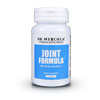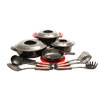Washboard Abs
One Secret To Getting Flat Chiseled Abs Again
By Kevin DiDonato MS, CSCS, CES
Guys, we have a problem! A very BIG problem too! The minute we are born, we start the aging process. Flash forward a few years to the age of 12 or 13 when the changes started to happen. Your little voice got deeper and manlier. You started to grow hair in places you would never have even dreamed would grow hair. Your body started to change as well. You started to notice you were stronger, able to run faster, and your chest was taking shape.
Puberty is a time in a man’s life when there is a transition from boy to man. Testosterone production starts to increase, resulting in a deeper voice, a chiseled chest and arms and, yes, the extra body hair. For some, sports became easier to play and we started to notice the girls! For some reason they were more attractive.
The big problem I mentioned before is as we get older there is a gradual decline in testosterone. Research points to the age of 50 as the magic number when we notice a decline in energy, which might be a sign of declining testosterone levels. Declining testosterone affects us in many ways. A lack of motivation, decreased energy levels, a decrease in sex drive and sexual enjoyment, and a decrease in muscle strength and size can be typical reactions.
The decrease in muscle size and strength can be alarming to any man. I know I have done everything I can to get back to the chiseled, lean physique I once had in my twenties. What I have noticed is most men tend to gain weight around their bellies than anywhere else. Let me explain why.
What the heck is LPL?
A gradual decline in testosterone, results in our bodies being unable to process abdominal fat correctly. A hormone in the body called lipoprotein lipase (LPL) aids the breakdown of fat into usable nutrients for energy. The problem is this: When there is a decrease in testosterone, the hormone, LPL, increases in activity resulting in fat breakdown and storage in the cells of the body and not used for energy. Fat breakdown from lipoprotein lipase happens in two areas of the body: the abdominal region, specifically the adipose tissue, and in muscle.
Simply put, when LPL is increased, the body breaks down fat and stores it in the cells for use later. Results: higher stored triglycerides in the form of adipose tissue. When LPL is decreased, the opposite is true. The LPL in the muscle activates and breaks down more fat as opposed to blood sugar for energy. This is a good thing! The body is now using the stored energy from fat as a main energy source. The problem is this: some, if not most of us, have high LPL activity resulting in more fat storage.
Testosterone and Diabetes
This gets complicated with diabetes thrown into the mix. Diabetes, a metabolic disease characterized by the body either not producing enough insulin or the cells are not sensitive to insulin, rendering the body unable to remove sugar from the blood. When diabetes is controlled, people are able to process sugar and use it for energy due to increased insulin capabilities, or the cells are more sensitive to insulin secreted in the body. The drawback is when it is NOT under control.
Without proper control of insulin and blood sugar, our body utilizes the sugar in the blood and from food as energy and stores the rest in the cells. Where do you think we store it? You got it - whatever is not used for energy, we store as fat in the form of adipose tissue. There are three types of fat we need to discuss before we go any further.
Subcutaneous, Visceral and Brown
The three types of fat in the body: adipose or subcutaneous, brown fat, and visceral fat. Adipose tissue, namely white adipose or subcutanenous, is fat that lies right over our abs. This type of fat is stored energy, and is used in times of starvation, during intense or long duration cardio, or at rest to enable our brain to keep functioning. High levels of adipose and visceral fat pose potential health risks. The second type is visceral fat. This is the worst type of fat you can have. Higher levels of visceral fat, commonly found deep in the abdomen, is linked to higher cholesterol levels, LDL cholesterol, and triglycerides. This type of fat poses a much higher risk for developing cardiovascular disease and other metabolic diseases. The increased risk is due to the higher triglycerides, cholesterol, and LDL.
The last is Brown Fat, or BAT. This is a great type of fat, and there is plenty of research praising benefits brown fat has on the body. The reason for the brown color is due to the abundance of mitochondria in the tissue. This fat utilizes adipose fat as fuel to produce heat, resulting in reduced weight and body fat stores. Great news for the fight against obesity!
Now the fat is out of the way, let’s turn our attention to how increasing testosterone can help you lose that stubborn belly fat. If you’re like me, you have done all the moves you could possibly do for the abs to help strengthen them, but it seems like nothing can get rid of stubborn belly fat.
Now don’t be afraid about having stubborn belly fat forever. This information should put your mind at ease. Increasing levels of testosterone might possibly decrease the activity of LPL - resulting in decreases in belly fat! This hormone, which decreases with age, can actually help to give us the lean and chiseled look. Research done by Rebuffee-Sevia et al. reinforces testosterone’s ability to fight belly fat.
The Research
Their research points out two main things: increased levels of testosterone increases lipolytic potential, and it decreases the activity of LPL in adipose tissue. Their research showed increased testosterone levels resulted in decreased waist-to-hip ratio and an increase in the responsiveness of lipolytic activity due to the hormone norepinephrine. They concluded increased testosterone results in adaptations in the metabolism of abdominal fat in the forms of adipose tissue and visceral fat. Results: decreased abdominal (adipose and visceral) fat levels. Great news! Here’s more.
Research done by Marin et al. also concluded increased testosterone levels resulted in a decrease of adipose triglycerides and a similar decrease in LPL activity. Interestingly enough, bad visceral fat decreased as well. They also found benefits including: a decrease in fat mass, fasting blood glucose levels, both fasting plasma cholesterol and triglycerides levels, and an increase in insulin activity related to sugar glucose control. The bottom line: increased testosterone results in metabolic and circulatory improvements. Want more?
Here is a great study for men suffering low testosterone who also have Diabetes. This research shows tremendous promise for men with diabetes AND low testosterone levels.
Research by Boyanor et al. concluded increased testosterone has positive effects at reducing visceral fat. Their research resulted in increased sensitivity to insulin and a similar decrease in LPL activity. This helped break down the fat into usable fuel for the body enabling its use at the muscular level, sparing glucose. Their subjects showed a decrease in body weight, waist-to-hip ratio, and overall body fat, especially adipose and visceral fat in the abdomen. Very important information in the possibility of testosterone in the management of Diabetes!
Sum it all up….
Hard work and dedication to diet and exercise will help shed belly fat. But wouldn’t it be nice to have an advantage? There are plenty of different herbs and other natural ways to increase your testosterone. In fact, there are five special nutrients in nature shown to increase testosterone and sex drive, andPrograde K20 has those exact nutrients in it! If you are middle-aged, these five special ingredients might help make your dreams a reality. Look no further, and find a way to possibly raise your testosterone and shed your belly fat and achieve the lean, chiseled look you have been dreaming about.


